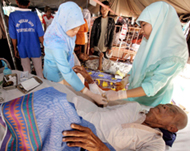Aid arrives in Indonesia as toll rises
Aid trickled in for survivors of an earthquake that killed more than 5,000 people on Indonesia’s Java island, but tens of thousands of homeless are foraging on their own in heavy rain for food and shelter.

Many survivors who were injured or whose homes were destroyed by the earthquake prepared to spend a third night in the open on Monday. Some found shelted in the grounds of hospitals and mosques or in makeshift shelters beside the rubble of their houses.
A UN aeroplane loaded with tents and emergency gear landed near the earthquake zone, as survivors cleared debris or stood on roads lined with crumpled buildings, pleading for money to buy food.
It was loaded with water, tents, stoves and cooking sets that officials said was be distributed late on Monday.
As aid began to flow, relief vehicles clogged the main road leading to the quake zone.
Paul Dillon, spokesman for the UN-affliated International Organisation of Migration, said: “The access to remote areas is very difficult; these roads are quite narrow. It’s creating some sort of bottleneck to deliver supplies.”
Some villagers had received clothing and food, but most were fending for themselves more than 48 hours after the quake struck, turning their homes into piles of brick, tiles and wood in less than a minute.
 |
|
Volunteers treat an earthquake |
On Sunday, three UN trucks brought high-energy biscuits to some of the worst-hit districts and two Singaporean military cargo planes arrived at Yogyakarta airport with doctors and medical supplies.
Countries across Asia and the world have pledged millions of dollars, tons of supplies and hundreds of personnel, and Indonesia said late on Sunday it would allocate $107 million to help rebuilding the affected areas.
Disaster zone
Saturday’s quake was the fourth destructive temblor to hit Indonesia in the past 17 months, including the one that spawned the December 26, 2004, Asian tsunami that killed 230,000 people, most of them in Indonesia.
 |
|
An estimated 200,000 people |
The country also is battling a spiralling human bird flu case load, a spate of terror attacks by al-Qaeda-linked Islamic members and the threat of eruption from Mount Merapi, just north of the quake zone.
Electricity and water supplies are still down in much of the region, while torrential rain that has fallen since the disaster has added to the misery facing survivors.
The government lowered the official toll from nearly 5,000 to 4,315, after revising figures for the hard-hit district of Klaten.
An estimated 200,000 people have been left homeless, most of whom are living in shacks close to their former homes or in shelters put up in rice fields. Hospitals overflowed with wounded survivors.
Indonesia, the world’s largest archipelago, is prone to seismic upheaval due to its location on the so-called Pacific Ring of Fire, an arc of volcanos and fault lines encircling the Pacific Basin. It has 76 volcanos, the largest number in the world.